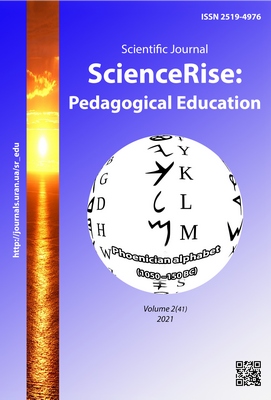The beginning of the system of assistance to children with visual disabilities: historical and bibliographical aspect
DOI:
https://doi.org/10.15587/2519-4984.2021.228233Keywords:
children with visual impairments, assistance, special education, correctional assistance, history, teachingAbstract
The scientific article reveals some of the historical facts of the beginning of helping children with visual impairments. The main chronological events of caring for children with the noted category of disorders are noted, which later became the basis for the development of special education, in particular, typhlopedagogy.
The article describes the emergence of hospitals, shelters for orphans, sick and crippled people throughout Rus, which testifies to the attention of society to their lives. The facts of the search for ways of treatment and the development of methods, principles and means of teaching people with impaired psychophysical development are outlined. Based on the study of historical sources, the times of Kyivan Rus are characterized, when in some monasteries and churches premises were allocated for the residence of orphans and crippled children. There is information about the first institution in Ukraine, which was guarded by the problem of blind people, although it did not provide for special education and training for this category of persons.
An important point of the article is the definition of the role of the state in the care of visually impaired persons. It is noted that in the 17th and 18th century in Ukraine, social work began to take care of orphans and people with disabilities. From the end of the 17th century, orphans and children of "mutilations" began to be in the care of shelters and hospitals, which was stipulated by a number of state decrees. In the 30s of the 18th century, a new form of guardianship over the disabled was introduced, patronage, which still exists in a modernized form. For a deeper retrospective of the state's assistance to children with visual impairments, it is necessary to investigate the facts of historical sources from the 18th century to the present
References
- Bondar, V. I. (2005). Problemy korektsiinoho navchannia u spetsialnii pedahohitsi. Kyiv: Nash chas, 176.
- Bondar, V. I., Zolotoverkh, V. V. (2007). Istoriia olihofrenopedahohiky. Kyiv: Znannia, 375.
- Suprun, M. O. (2005). Korektsiine navchannia uchniv dopomizhnykh zakladiv osvity: vytoky, stanovlennia ta rozvytok (kinets XIX –persha polovyna XX st.). Kyiv, 328.
- Fedorenko, S. V. (2012). Stanovlennia ta rozvytok vitchyznianoi tyflopedahohiky. Kyiv, 417.
- Shevchenko, O. E. (2004). Stanovlennia ta rozvytok systemy pidhotovky defektolohichnykh kadriv dlia zakladiv spetsialnoi osvity Ukrainy (1918–1941 rr.). Kyiv, 252.
- Silver, L. B. (1981). The Relationship between Learning Disabilities, Hyperactivity, Distractibility, and Behavioral Problems: A Clinical Analysis. Journal of the American Academy of Child Psychiatry, 20 (2), 385–397. doi: http://doi.org/10.1016/s0002-7138(09)60996-1
- Gleeson, B. (1995). Disability: a state of mind? Australian Journal of Social Issues, 30 (1), 10–23. doi: http://doi.org/10.1002/j.1839-4655.1995.tb01023.x
- Synova, Ye. P. (2012). Osoblyvosti rozvytku ta vykhovannia osobystosti pry hlybokykh porushenniakh zoru. Kyiv: NPU imeni M. P. Drahomanova, 442.
- Kulyk, L. H. (2006). Vnesok O. M. Shcherbyny u stanovlennia ta rozvytok vitchyznianoi tyflopedahohiky. Kyiv, 195.
- Kunenko, L. O. (2010). Teoretyko-metodychni zasady intehratsiinoi spriamovanosti muzychnoi osvity molodshykh shkoliariv z porushenniamy zoru. Kyiv, 44.
- Kaschenko, V. P. (1912). Istoricheskoe i sovremennoe sostoianie vospitanie i obuchenie defektivnikh detei v Rossii. Defektivnye deti i shkola, 255–277.
- Zamskii, Kh. S. (1980). Istoriia oligofrenopedagogiki. Moscow: Prosveschenie, 398.
- Lyndina, Ye., Kozynets, O. (2020). The retrospective analysis of the speech-therapy assistance to children with the disorders of the intellectual development. Scientific Papers of Berdiansk State Pedagogical University Series Pedagogical Sciences, 3, 108–117. doi: http://doi.org/10.31494/2412-9208-2020-1-3-108-117
Downloads
Published
How to Cite
Issue
Section
License
Copyright (c) 2021 Евгения Юрьевна Лындина

This work is licensed under a Creative Commons Attribution 4.0 International License.
Our journal abides by the Creative Commons CC BY copyright rights and permissions for open access journals.
Authors, who are published in this journal, agree to the following conditions:
1. The authors reserve the right to authorship of the work and pass the first publication right of this work to the journal under the terms of a Creative Commons CC BY, which allows others to freely distribute the published research with the obligatory reference to the authors of the original work and the first publication of the work in this journal.
2. The authors have the right to conclude separate supplement agreements that relate to non-exclusive work distribution in the form in which it has been published by the journal (for example, to upload the work to the online storage of the journal or publish it as part of a monograph), provided that the reference to the first publication of the work in this journal is included.








